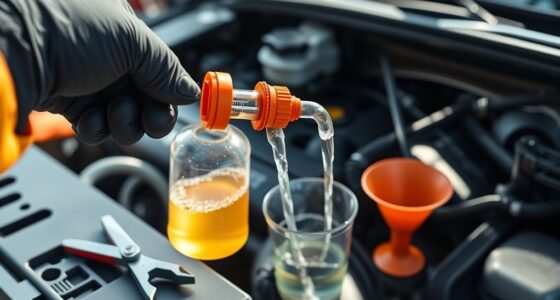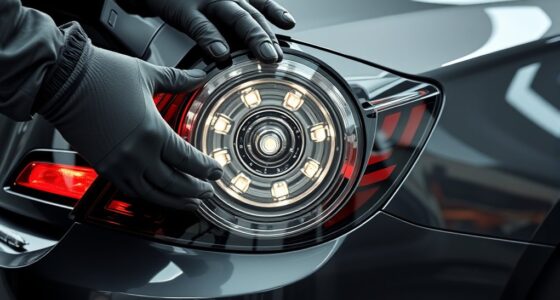If you experience a flat tire, find a safe spot away from traffic, turn on hazard lights, and loosen the lug nuts before lifting the vehicle with a jack. For a quick fix, use a tire repair kit to patch small punctures and keep driving until you reach a service station. You can also jump-start a weak battery by connecting jumper cables properly. Keep learning more simple roadside repairs so you’re prepared for unexpected emergencies.
Key Takeaways
- Safely change or replace a flat tire using a jack, lug wrench, and spare tire following proper procedures.
- Use a tire repair kit to patch small punctures temporarily, ensuring proper cleaning and sealing.
- Jump-start a dead battery with jumper cables, connecting to a functioning vehicle and following safety steps.
- Inspect and tighten loose or damaged hoses, belts, or clamps to prevent breakdowns.
- Check and top off essential fluids like oil, coolant, and brake fluid to maintain vehicle reliability.

Have you ever found yourself stranded on the side of the road with a sudden vehicle problem? It’s a frustrating situation, but knowing a few simple emergency repairs can make all the difference. One of the most common issues drivers face is a flat tire. If you notice your tire looks flat or the car pulls to one side, you might need to do some tire patching right there on the spot. First, find a safe location away from traffic, turn on your hazard lights, and gather your tools, including a spare tire, jack, and tire repair kit if you have one. Carefully loosen the lug nuts before lifting the vehicle with the jack. Once the tire is off, inspect it for punctures or embedded objects. If you spot a small nail or screw, you might be able to patch it yourself using a tire patching kit. Follow the instructions carefully—usually, you’ll need to clean the puncture area, apply the patch, and ensure it’s sealed properly. This quick fix can get you back on the road temporarily until you can visit a repair shop for a more permanent solution. Remember, tire patching is a handy skill that saves you time and money during roadside emergencies. Additionally, understanding vehicle maintenance can help prevent such issues from occurring unexpectedly.
Another common roadside emergency involves a dead or weak battery. If your car won’t start and your dashboard shows warning lights or a clicking sound, it’s likely a battery issue. You can perform a battery jump starting to get your vehicle going again. First, ensure both cars are turned off and parked close enough for the jumper cables to reach each battery. Connect the positive (red) clamp to the dead battery’s positive terminal, then attach the other end to the good battery’s positive terminal. Next, connect the negative (black) clamp to the good battery’s negative terminal, and finally, attach the other black clamp to an unpainted metal surface on the dead car’s engine block or chassis—this helps prevent sparks. Once everything’s connected securely, start the engine of the working vehicle, then attempt to start your car. If successful, let your engine run for a few minutes to recharge the battery. Carefully disconnect the cables in reverse order. This process is straightforward but requires caution—always follow safety procedures to avoid sparks or electrical damage. Carrying jumper cables and knowing how to use them can be a lifesaver when your battery dies unexpectedly.
In emergency roadside situations, being prepared with basic skills like tire patching and battery jump starting can save you from costly tow services and long waits. Keep a well-stocked emergency kit in your vehicle, and practice these techniques when you have time. They’re simple skills that give you confidence and control when facing unexpected vehicle troubles.
Frequently Asked Questions
What Safety Precautions Should I Take Before Starting Repairs?
Before starting repairs, you should prioritize safety. Always wear proper safety gear like gloves and eye protection to prevent injuries. Confirm your vehicle is on a flat, stable surface and turn off the engine. Use caution around hot or moving parts, and keep a fire extinguisher nearby. Double-check your vehicle’s maintenance records to understand potential hazards. Taking these precautions helps protect you and makes your roadside repairs safer.
Can I Fix Major Engine Problems Roadside?
You can attempt to fix major engine problems roadside if you’re experienced, but it’s risky. Start with diagnostic tests to identify the issue accurately. If it’s a minor problem, you might be able to perform simple repairs like replacing a belt or hose. However, for a full engine overhaul or complex issues, it’s best to call roadside assistance or a mechanic. Safety and proper diagnosis are key to avoiding further damage.
What Tools Are Essential for Emergency Repairs?
When you’re faced with emergency repairs, you need the right tools. Essential items include a basic tire repair kit to handle flats quickly, and an emergency flashlight to see clearly in low light conditions. A wrench set, jumper cables, and gloves are also helpful. Keep these tools in your trunk so you’re prepared for unexpected situations, ensuring safety and quick fixes until professional help arrives.
How Do I Identify a Flat Tire Quickly?
To identify a flat tire quickly, start by paying attention to your tire pressure; if it feels softer than usual or your dashboard shows a warning, that’s a sign. Also, listen for unusual thumping sounds or notice if your vehicle pulls to one side. Visual checks help too—look for a visibly deflated tire or sidewall damage. Recognizing these signs early can save you time and prevent further damage.
When Should I Call for Professional Roadside Assistance?
Did you know that over 70% of drivers experience unexpected breakdowns? You should call professional roadside assistance when you notice signs like your car battery needing replacement or issues with fuel system troubleshooting. If you’re unsure about diagnosing problems or if repairs seem complex, it’s safer to seek expert help. Don’t risk further damage—call for help when you’re uncomfortable handling issues like battery or fuel system repairs yourself.
Conclusion
With a little knowledge and a willingness to work, you can handle many roadside setbacks swiftly and smoothly. From changing a tire to checking fluid levels, mastering these simple skills boosts your confidence and keeps you moving. Remember, preparedness prevents panic, so stay steady and skilled. With these handy hacks in hand, you’ll handle any highway hiccup with hope, hustle, and a hint of heroism. Stay savvy, stay safe, and keep those roadside repairs within reach.








